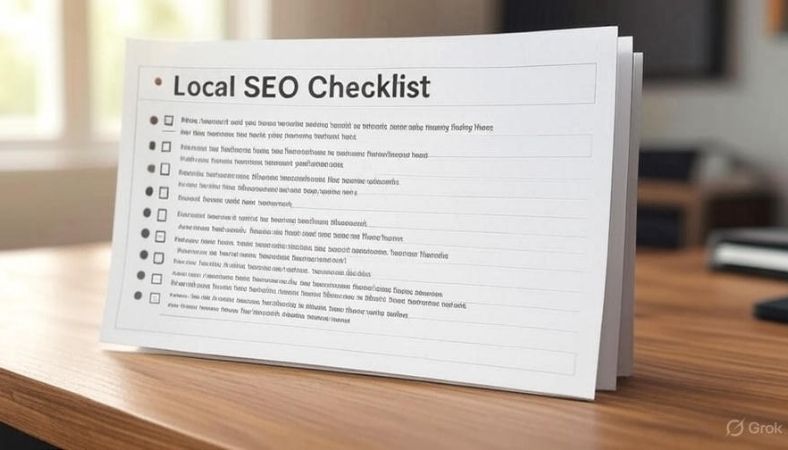Introduction
Want your business to shine locally? A Local SEO checklist is your secret weapon. It helps small businesses stand out. Customers search for nearby services daily. Google prioritizes local results now. Think about it: people want coffee shops, plumbers, or gyms close by.
Optimizing for local search drives foot traffic. It boosts online visibility too. This guide shares a clear Local SEO checklist. You’ll learn what it is, how to use it, and why it works. Ready to rule your neighborhood? Let’s get started! Well-organized data. Structured data SEO is the magic wand that gives them exactly what they want.
What Is a Local SEO Checklist?
Defining Local SEO
Local SEO helps businesses rank locally. It targets customers in specific areas. A Local SEO checklist organizes key tasks. It ensures your business appears in local searches. For example, “cafes near me” triggers local results. Google uses location data for this. The checklist covers optimization steps. It includes Google Business Profile, citations, and reviews. These make your business discoverable. Local SEO differs from general SEO. It focuses on geography, not just keywords.

Why Local SEO Matters
Local searches drive real-world actions. People visit stores after searching. A Local SEO checklist maximizes your visibility. It helps you beat nearby competitors. Google’s “Map Pack” shows top businesses. Optimized sites rank higher there. This means more clicks, calls, and visits. Local SEO also builds trust. Customers rely on reviews and profiles. A strong checklist ensures consistency. It’s vital for small businesses. Without it, you miss local customers.
How It Differs From General SEO
General SEO targets broad audiences. Local SEO narrows to specific regions. It emphasizes location-based keywords. For example, “best pizza Chicago” is local. A Local SEO checklist includes unique steps. You optimize profiles, not just websites. Citations and reviews play big roles. General SEO focuses on backlinks, content. Local SEO adds physical location signals. Both work together for success. The checklist makes local efforts simple.
Step-by-Step Local SEO Checklist
Step 1: Optimize Google Business Profile
Claim your Google Business Profile first. It’s free and essential. Fill out every detail accurately. Add your business name, address, phone. Include hours and categories too. Upload high-quality photos regularly. Write a compelling business description. Use keywords like your city name. Verify your profile with Google. This boosts your Map Pack chances. Update it monthly for accuracy. A strong profile drives local trust.
Step 2: Build Consistent Citations
Citations are online business mentions. They include name, address, phone (NAP). Ensure NAP is identical everywhere. List on Yelp, Yellow Pages, others. Local directories matter most here. Check for errors in existing citations. Fix inconsistencies using tools like Moz Local. Submit to industry-specific directories too. Consistent citations boost local rankings. Google trusts accurate business data. This step strengthens your credibility. Monitor citations regularly for changes.

Step 3: Encourage Customer Reviews
Reviews influence local rankings heavily. Ask happy customers to leave feedback. Make it easy with direct links. Respond to reviews, positive or negative. This shows you value customers. Aim for Google and Yelp reviews. More reviews improve your visibility. Highlight positive ones on your site. Avoid fake reviews—they hurt trust. Encourage detailed, honest feedback. Reviews are a Local SEO checklist must. They build credibility fast.
Step 4: Optimize Your Website
Make your website local-friendly. Add location pages for each area. Include city-specific keywords naturally. Embed Google Maps on contact pages. Ensure your site is mobile-responsive. Most local searches happen on phones. Add NAP to your footer. Use schema markup for local signals. Optimize title tags with locations. For example, “Denver Plumbing Services.” Fast loading speeds help too. A local-optimized site ranks higher.
Step 5: Leverage Local Content
Create content for your area. Write blog posts about local events. Share community news or tips. For example, “Best Hiking Spots in Seattle.” Use local keywords in content. Engage users with relevant stories. Post about local partnerships or charities. This builds community trust. Share content on social media. Link to it from your site. Local content boosts engagement. It’s a key Local SEO checklist step.
Advantages and Disadvantages of a Local SEO Checklist
Advantages
A Local SEO checklist simplifies optimization. It drives more local traffic fast. Map Pack rankings boost visibility. Customers trust businesses with reviews. Optimized profiles attract more clicks. Local SEO levels the playing field. Small businesses compete with big brands. It’s cost-effective compared to ads. Mobile users find you easily. Voice search benefits from local signals. Consistent citations build credibility. Results are measurable and impactful.
Disadvantages
Local SEO takes ongoing effort. Maintaining citations is time-consuming. Reviews require constant monitoring. Negative feedback can hurt rankings. Not all businesses have physical locations. Some niches face heavy competition. Results may take weeks or months. Technical setup can feel complex. Schema markup needs regular updates. Small mistakes cause ranking drops. Limited budgets may slow progress. Patience is key for success.
FAQs About a Local SEO Checklist
What Is a Local SEO Checklist?
It’s a guide for local optimization. It lists steps to rank higher. It targets nearby customers effectively.
Do I Need a Physical Store?
No, service-based businesses work too. Use service area settings. Optimize for regions you cover.
How Long Until Results Appear?
Results vary by competition, effort. Some see gains in weeks. Others take months for impact.
Can Reviews Hurt My Rankings?
Negative reviews may affect trust. Respond professionally to mitigate damage. Encourage positive feedback to balance.
Is It Worth It for Small Businesses?
Yes, small businesses benefit most. Local SEO drives foot traffic. It’s affordable and effective.
What’s the Best Tool for Local SEO?
Google Business Profile is key. Moz Local and BrightLocal help too. They streamline citations, tracking.
Bonus Points: Advanced Local SEO Checklist Tips
Use Hyperlocal Keywords
Target neighborhoods, not just cities. For example, “Brooklyn coffee shop” works better. Hyperlocal terms attract nearby customers. Research what locals search for. Add these to your content. This sharpens your Local SEO checklist. It makes you hyper-relevant. Tools like Google Keyword Planner help. Check competitor keywords too. Hyperlocal focus drives precise traffic.
Engage on Social Media Locally
Post about local events, news. Tag nearby businesses or landmarks. Use location-based hashtags often. Engage with local followers directly. Share user-generated content from customers. This builds community trust fast. Social signals boost local rankings. Link social posts to your site. It’s a smart checklist addition. Stay active and consistent.
Track Local Competitors
Analyze competitors in your area. Check their Google Business Profiles. Look at their reviews, keywords. See what schemas they use. Tools like SEMrush show their strategies. Adapt what works for you. Don’t copy—improve on it. Competitor insights refine your checklist. They reveal gaps to exploit. Stay one step ahead.
Optimize for Voice Search
Voice search loves local queries. Optimize for phrases like “near me.” Use conversational keywords in content. Schema markup helps voice assistants. For example, “LocalBusiness” schema works well. This future-proofs your SEO efforts. Voice search is growing fast. Add it to your checklist. It’s a small tweak with big impact.
Conclusion
A Local SEO checklist transforms your business. It puts you on Google’s Map Pack. Nearby customers find you easily. Optimized profiles build trust fast. Consistent citations boost your credibility. Reviews and local content engage communities. This guide’s steps are actionable. Start with Google Business Profile today. Add schema, track results, refine. The effort pays off in traffic. Small businesses gain the most. Local SEO is cost-effective, powerful. Don’t let competitors outshine you. Use this checklist to dominate locally. Your business deserves the spotlight.

